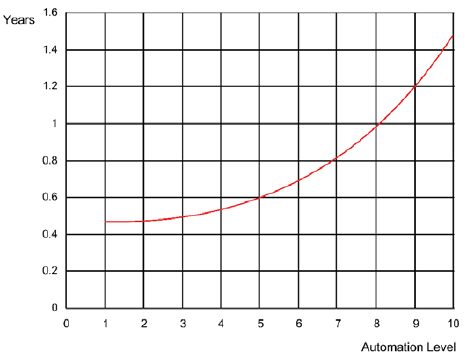4.3.3 Automation
Your production lines are partially integrated. Therefore low automation on one line will hinder automation on another. A line’s effective automation is 50% of its automation rating plus 50% of the lowest automation of all production lines. If a production line has an automation of 8.0, and the lowest automation of all the lines is 4.0, the first production line will have an effective automation of 6.0.
(8.0 * 0.5) + (4.0 * 0.5) = 6.0
Automation levels are given a scale of 1.0 to 10.0. The lowest automation level is 1.0; the highest level is 10.0. At the start of the simulation, all assembly lines have an automation level between 3.0 and 5.0. As automation levels increase, the number of labor hours required to produce each unit falls.
At an automation rating of 1.0, labor costs are highest. Each additional point of automation decreases labor costs approximately 10%. At a rating of 10.0, labor costs fall about 90%.

Labor costs increase each year because of the Annual Raise in labor's contract.
Despite its attractiveness, two factors should be considered before raising automation:
- Automation is expensive: At $4.00 per point of automation, raising automation from 1.0 to 10.0 costs $36.00 per unit of capacity;
- As you raise automation, it becomes increasingly diffi cult for R&D to reposition products short distances on the Perceptual Map. For example, a project that slightly moves a product 0.7 on the map takes significantly longer at an automation level of 8.0 than at 5.0 (Figure 4.3). Long moves are less affected. You can move a product a long distance at any automation level, but the project will take between 2.5 and 3.0 years to complete.
4.3.4 Changing Automation
For each point of change in automation, up or down, the company is charged $4.00 per unit of capacity. For example, if a line has a capacity of 1,000,000 units, the cost of changing the automation level from 5.0 to 6.0 would be $4,000,000. Reducing automation costs money. If you reduce automation, you will be billed for a retooling cost. The net result is you will be paying money to make your plant less efficient. While reduced automation will speed R&D redesigns, by and large it is not wise to reduce an automation level. Changes in automation require a full year to take effect– change it this year, use it next year.
